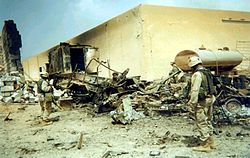Al-Samoud 2
| Al Samoud | |
|---|---|
 An Al Samoud missile captured by US forces in Southern Iraq (2003) | |
| Type | Single-stage ballistic missile |
| Service history | |
| In service | 2003 |
| Used by | Iraqi Army |
| Production history | |
| Manufacturer | Iraq |
| Produced | 2001-2003 |
| Specifications | |
| Length | 7,14m |
| Diameter | 760mm |
| Warhead | 280kg |
| Propellant | Liquid propellant (Al-Samoud)RFNA/UDMH[1] Solid propellant (Ababil-100) |
Operational range | 180km |
Guidance system | Inertial |
| Accuracy | 2.0 km CEP[1] |
Launch platform | Mobile launcher |
Al-Samoud (الصمود, alternately Al-Samed, which means steadfastness in Arabic)[2] was a liquid-propellant rocket tactical ballistic missile developed by Iraq in the years between the Gulf War and the 2003 Invasion of Iraq. The Iraqi army also developed a solid-fuel rocket version known as Ababil-100.
Development
[edit]The missile was essentially a scaled-down Scud,[citation needed] though parts were mostly derived from the Soviet S-75 Dvina surface-to-air missile. The first test-firing was carried out as early as 1997[2] and was supervised by UNSCOM.[3] The production started in 2001, and the goal was the assembly of ten missiles each month. The Al Samoud 2 was not fully operational by 2003, but some of them had been already delivered to the Iraqi army.[citation needed]
Engine
[edit]The rocket engine evolved from the S-75 Dvina design and the thrust vector controls from the Scud. The system also included an Iraqi-designed mobile launcher similar to the Al-Nida, built for the missile Al Hussein,[4] produced by the Iraqi company Al-Fida.[5]
Payload
[edit]The missile carried a 280 kilogram warhead that was half high explosives and half protective steel shell. The explosive charge weighed 140 kg, made of a mixture of 84 kg of RDX=60%, 42 kg of TNT= 30% and 14 kg of aluminium= 10%, the latter used as an energetic blast enhancer. The payload was also designed to upload different types of bomblets.[citation needed]
Guidance
[edit]The guidance package was assembled by cannibalizing gyroscopes from the Chinese Silkworm cruise missile.[citation needed] A source is cited as claiming that there were inertial and even GPS guidance systems illegally imported from Belarus, but these allegations have not been confirmed.[citation needed]
Banned by the UN
[edit]
On February 13, 2003, a UN panel reported that Iraq's Al-Samoud 2 missiles, disclosed by Iraq to weapons inspectors in December, have a range of 180 km, in breach of UNSCR 1441. The limit allowed by the UN is 150 km.[citation needed]
Iraq agreed to destroy the Al-Samoud 2 long range missiles, and by mid-March 2003, a number had been destroyed. Although UNMOVIC ordered to stop its production, Iraq assembled some 20 missiles during the early months of 2003.[citation needed]
American forces found a cache of 12 Al Samoud missiles south of Baiji on July 21, 2003.[citation needed]
Operational history (March–April 2003)
[edit]
A number of Al-Samoud 2 missiles were fired at Kuwait during the 2003 conflict.[6] One of them, aimed at the Coalition Headquarters at Camp Doha, was successfully intercepted by a Patriot missile on March 27. Some debris hit buildings inside the US base.[7] The other missiles were also shot down or landed harmlessly in the desert.
A similar development, the Al-Fahd or Ababil-100, a solid propellant version of the Al-Samoud, was also used by the Iraqi army during the invasion. The Headquarters of the 2nd Brigade, US 3rd Infantry Division, were struck south of Baghdad by a missile of this kind on April 7. Three soldiers and two foreign reporters were killed in the blast.[8][9][10][11][12]
See also
[edit]References
[edit]- ^ a b "GIS SPecial Topical Studies:Iraq war 2003". ISSA Special Reports. Archived from the original on 17 March 2017.
- ^ a b Miller, David: Conflict Iraq: Weapons and tactics of US and Iraqi Forces. Zenith imprint, 2003, page 22. ISBN 0-7603-1592-2
- ^ Iraq's missile programs Archived 2015-02-18 at the Wayback Machine
- ^ Cordesman, Anthony (2003). The Great Iraqi Missile Mystery: The Military Importance of the Ababil, Al Samoud II, Al Fatah, Badr 2000, and Al Huysayn Archived 2010-02-09 at the Wayback Machine. Center for Strategic and International Studies, 25 February 2003
- ^ Unmovic - IAEA Press Statement on Inspection Activities in Iraq, 19 February 2003
- ^ The sources claim that only three to five Al-Samoud 2 were actually used by the Iraqis, the remainder missiles were purportedly Ababil-100/Al-Fahd or Laith-90, this latter a locally upgraded version of the Frog-7:
- www.cdi.org Archived 2003-12-23 at the Wayback Machine
- ^ www.cnn.com/2003
- ^ Zucchino, David: Thunder Run: The Armored Strike to Capture Baghdad. Grove Press, 2004, page 162.
- ^ "He (Lt. Col. Wesley, second in command) had gotten only thirty feet from his vehicle when a powerful Abril (sic) missile hit it dead center." Lacey, Jim:Takedown: the 3rd Infantry Division's twenty-one day assault on Baghdad. Naval Institute Press, 2007, page 243. ISBN 1-59114-458-2
- ^ Iraqi missile hits Army base, By Steven Lee Myers. The New York Times, 04/07/2003.
- ^ Nach ersten Erkenntnissen soll es sich um eine irakische Boden-Boden-Rakete vom Typ Ababil-100 mit einer Reichweite von 130 Kilometern handeln. Focus magazine, 14 April 2003, report by Gudrun Dometeit (in German)
- ^ Perry, Walter L. (2015). Operation Iraqi Freedom: Decisive War, Elusive Peace (PDF). RAND Corporation. p. 178. ISBN 978-0-8330-4192-0.
Lua error in Module:Navbox at line 535: attempt to get length of local 'arg' (a number value).
